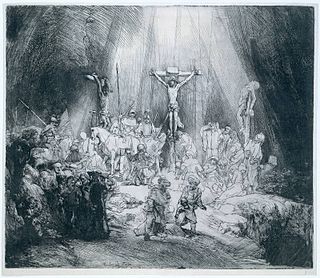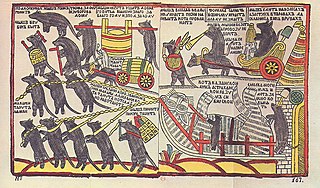
An incunable, or sometimes incunabulum, is a book, pamphlet, or broadside printed in Europe before the 16th century. Incunabula are not manuscripts, which are documents written by hand. As of 2014, there are about 30,000 distinct known incunable editions extant, but the probable number of surviving copies in Germany alone is estimated at around 125,000. Through statistical analysis, it is estimated that the number of lost editions is at least 20,000. Around 550,000 copies of around 27,500 different works have been preserved worldwide.

The morality play is a genre of medieval and early Tudor theatrical entertainment. In their own time, these plays were known as interludes, a broader term for dramas with or without a moral. Morality plays are a type of allegory in which the protagonist is met by personifications of various moral attributes who try to prompt them to choose a good life over one of evil. The plays were most popular in Europe during the 15th and 16th centuries. Having grown out of the religiously based mystery plays of the Middle Ages, they represented a shift towards a more secular base for European theatre. Hildegard von Bingen's Ordo Virtutum composed c. 1151, is the earliest known morality play by more than a century, and the only Medieval musical drama to survive with an attribution for both the text and the music.

The World and the Child is an anonymous English morality play. Its source is a late 14th-century or 15th-century poem The Mirror of the Periods of Man's Life, from which the play borrows significantly while reducing the number of characters. It is thought to have influenced William Shakespeare's Henry IV, Part 1.

Ship of Fools is a painting by Hieronymus Bosch, now on display in the Musée du Louvre, Paris. The surviving painting is a fragment of a triptych that was cut into several parts. The Ship of Fools was painted on one of the wings of the altarpiece, and is about two thirds of its original length. The bottom third of the panel belongs to Yale University Art Gallery and is exhibited under the title Allegory of Gluttony. The wing on the other side, which has more or less retained its full length, is the Death and the Miser, now in the National Gallery of Art, Washington, D.C.. The two panels together would have represented the two extremes of prodigality and miserliness, condemning and caricaturing both. The Wayfarer was painted on the right panel rear of the triptych. The central panel, if existed, is unknown.

The Nuremberg Chronicle is an illustrated encyclopedia consisting of world historical accounts, as well as accounts told through biblical paraphrase. Subjects include human history in relation to the bible, illustrated mythological creatures, and the histories of important Christian and secular cities from antiquity. Finished in 1493 after years in the making, it was originally written in Latin by Hartmann Schedel, and a German version was translated by Georg Alt. It is one of the best-documented early printed books—an incunabulum—and one of the first to successfully integrate illustrations and text.

Block books, also called xylographica, are short books of up to 50 leaves, block printed in Europe in the second half of the 15th century as woodcuts with blocks carved to include both text and illustrations. The content of the books was nearly always religious, aimed at a popular audience, and a few titles were often reprinted in several editions using new woodcuts. Although many had believed that block books preceded Gutenberg's invention of movable type in the first part of the 1450s, it now is accepted that most of the surviving block books were printed in the 1460s or later, and that the earliest surviving examples may date to about 1451. They seem to have functioned as a cheap popular alternative to the typeset book, which was still very expensive at this stage. Single-leaf woodcuts from the preceding decades often included passages of text with prayers, indulgences and other material; the block book was an extension of this form. Block books are very rare, some editions surviving only in fragments, and many probably not surviving at all.

An old master print is a work of art produced by a printing process within the Western tradition. The term remains current in the art trade, and there is no easy alternative in English to distinguish the works of "fine art" produced in printmaking from the vast range of decorative, utilitarian and popular prints that grew rapidly alongside the artistic print from the 15th century onwards. Fifteenth-century prints are sufficiently rare that they are classed as old master prints even if they are of crude or merely workmanlike artistic quality. A date of about 1830 is usually taken as marking the end of the period whose prints are covered by this term.

Popular prints is a term for printed images of generally low artistic quality which were sold cheaply in Europe and later the New World from the 15th to 18th centuries, often with text as well as images. They were some of the earliest examples of mass media. After about 1800, the types and quantity of images greatly increased, but other terms are usually used to categorise them.

In printmaking, a state is a different form of a print, caused by a deliberate and permanent change to a matrix such as a copper plate or woodblock.

The Speculum Humanae Salvationis or Mirror of Human Salvation was a bestselling anonymous illustrated work of popular theology in the late Middle Ages, part of the genre of encyclopedic speculum literature, in this case concentrating on the medieval theory of typology, whereby the events of the Old Testament prefigured, or foretold, the events of the New Testament. The original version is in rhyming Latin verse, and contains a series of New Testament events each with three Old Testament ones that prefigure it. It is one of the most common books found as an illuminated manuscript, and also in early printing in both blockbook and incunabulum forms.

The Triumphal Arch is a 16th-century monumental woodcut print commissioned by the Holy Roman Emperor Maximilian I. The composite image was printed on 36 large sheets of paper from 195 separate wood blocks. At 295 × 357 centimetres (116 × 141 in), it is one of the largest prints ever produced and was intended to be pasted to walls in city halls or the palaces of princes. It is a part of a series of three huge prints created for Maximilian, the others being a Triumphal Procession which is led by a Large Triumphal Carriage ; only the Arch was completed in Maximilian's lifetime and distributed as propaganda, as he intended. Together, this series has been described by art historian Hyatt Mayor as "Maximilian's program of paper grandeur". They stand alongside two published biographical allegories in verse, the Theuerdank and Weisskunig, heavily illustrated with woodcuts.

Horestes is a late Tudor morality play by the English dramatist John Pickering. It was first published in 1567 and was most likely performed by Lord Rich's men as part of the Christmas revels at court that year. The play's full title is A new interlude of Vice containing the history of Horestes with the cruel revengement of his father's death upon his one natural mother. It has been proposed that John Pickering is likely to be the same person as lawyer and politician Sir John Puckering.

Johann, Johannes or Hans Wechtlin was a German Renaissance artist, active between at least 1502 and 1526, whose woodcuts are his only certainly surviving work. He was the most prolific producer of German chiaroscuro woodcuts, printed in two or more colours, during their period in fashion, though most of his output was of book illustrations.
The Play of the Weather is an English interlude or morality play from the early Tudor period. The play was written by John Heywood, a courtier, musician and playwright during the reigns of Henry VIII, Edward VI and Mary I and published by his brother-in-law, William Rastell, in 1533 as The Play of the Wether, a new and mery interlude of all maner of Wethers. It represents the Roman deity Jupiter on earth asking mortals to make cases for their preferred weather following heavenly dissension among the gods. It is the first published play to nominate "The Vice" on its title page.

The Lyme Caxton Missal is an incunable or early printed book containing the liturgy of the Mass according to the Sarum Rite, published in 1487 by William Caxton. The copy at Lyme Park, Cheshire, England, is the only nearly complete surviving copy of its earliest known edition. It is held in the library of the house and is on display to visitors.

The Triumphal Procession or Triumphs of Maximilian is a monumental 16th-century series of woodcut prints by several artists, commissioned by the Holy Roman Emperor Maximilian I. The composite image was printed from over 130 separate wood blocks; a total of 139 are known. Approximately 54 metres (177 ft) long, it is one of the largest prints ever produced. It was designed to be pasted to the walls in city halls or the palaces of princes to create a decorative frieze, an expression of the Emperor's power and magnificence: a pictorial form of the contemporaneous royal entry, which like many Renaissance entries looked back to the Roman triumph. Maximilian's papers show that he intended the procession to "grace the walls of council chambers and great halls of the empire, proclaiming for posterity the noble aims of their erstwhile ruler". It was one of several works of propaganda in literary and print form commissioned by Maximilian, who was always drastically short of money, and lacked the funds to actually stage such a ceremony, unlike his Habsburg descendants. It could also be bound as a book, and it is copies treated this way which have survived, as well as those from later reprints.

Passionate Journey, or My Book of Hours, is a wordless novel of 1919 by Flemish artist Frans Masereel. The story is told in 167 captionless prints, and is the longest and best-selling of the wordless novels Masereel made. It tells of the experiences of an early 20th-century everyman in a modern city.

The Idea is a 1920 wordless novel by Flemish artist Frans Masereel (1889–1972). In eighty-three woodcut prints, the book tells an allegory of a man's idea, which takes the form of a naked woman who goes out into the world; the authorities try to suppress her nakedness, and execute a man who stands up for her. Her image is spread through the mass media, inciting a disruption of the social order. Filmmaker Berthold Bartosch made an animated adaptation in 1932.
"The Lamentable and Tragical History of Titus Andronicus,"also called"Titus Andronicus' Complaint," is a ballad from the 17th century about the fictional Roman general, Titus, and his revenge cycle with the Queen of the Goths. Events in the ballad take place near the end of the Roman Empire, and the narrative of the ballad parallels the plot of William Shakespeare's play Titus Andronicus. Scholarly debate exists as to which text may have existed first, the ballad or the play. The ballad itself was first entered on the Stationers' Register in 1594, the same year the play was entered. Surviving copies of the ballad can be found in the British Library, in the Huntington Library, and at Magdalene College, Cambridge. Online copies of the facsimiles are also available for public consumption at sites such as the English Broadside Ballad Archive.

New Penguin Shakespeare is a series of the works of William Shakespeare published from 1967 to 1987 as an imprint of Penguin Books. Printed in paperback the editions were very popular in schools where they were used for teaching Shakespeare.















